 End-to-end content management has become significantly easier for one Microsoft team thanks to the Microsoft Power Platform and our entrepreneurial citizen developers.
End-to-end content management has become significantly easier for one Microsoft team thanks to the Microsoft Power Platform and our entrepreneurial citizen developers.
Our aging content management system needed to be replaced, so we—the Inside Track team in Microsoft Digital (MSD), the company’s IT organization—turned to the company’s citizen developer platform for help.
What did we do?
We moved our content management system for managing this website away from an older version of SharePoint to a more powerful and flexible Microsoft Power App built on a Microsoft Azure SQL back end. The new system relies on Microsoft Power Automate for workflows and Microsoft Power BI for reporting.
Our decision to overhaul the legacy system was prompted by performance issues and the need for scalability and compliance.

“As the previous content management system got used more, it just couldn’t scale—it got slow, very slow,” says Tracey Peyton, a director of technical development who supports the Inside Track team. “It was really a no-brainer to go to SQL for the back end and use Power Apps for the UI with Power Automate as the workflow because the scalability and interoperability is there.”
Running legacy systems can come with a host of challenges, including performance and compliance issues. As business needs evolved, the capabilities of Microsoft Power Platform unlocked a new way to efficiently manage the content publishing system.
“After issues with the previous platform reached a peak, it became abundantly clear that it wasn’t performing how the content experience managers needed it to,” Peyton says. “The Inside Track team decided to make the leap, and the results did not disappoint.”

The Inside Track team creates content that shows IT leaders and practitioners how Microsoft uses its own technology and services to support its employees and internal business groups.
Peyton, who is on the team, has been doing web development since 1993 as a pro developer. He says that the move to Microsoft Power Platform (which includes Microsoft Power Apps, Microsoft Power Automate, and Microsoft Power BI) and Microsoft Azure SQL had numerous benefits that couldn’t be ignored.
The best of both worlds
On top of Microsoft Power Platform’s increased capability to scale, it’s a system that both professional and citizen developers can collaborate within because of its flexibility and capabilities.
Citizen development uses in-house talent and expertise, accelerates solution delivery, and fosters innovation. It allows organizations to respond swiftly to changing demands and customize solutions to fit each team’s needs.
By automating repetitive tasks and streamlining workflows, low-code and no-code environments like Microsoft Power Platform can significantly enhance productivity for developers and customers alike. Employees can focus on higher-value tasks while routine, time-consuming activities are streamlined.
Peyton led the vanguard for the migration to Microsoft Power Platform. He credits Microsoft Power Platform for its short ramp-up time and extensive ability to connect with other platforms. As of the writing of this blog post, premium subscriptions can connect to over 350 connectors—and the list continues to grow.
“Almost out of the box, anyone can start building a customized app—with the wide variety of connectors available and the ability to leverage data and functionality from other systems, it’s straightforward,” Peyton says. “It gives you ease of access for citizen developers.”
Compliance is also an aspect that can easily outrun the abilities of a legacy system.
“Policies change much quicker than tech requirements—our move to Microsoft Power Platform allowed us to respond to policy needs much more quickly,” says Lukas Velush, a senior business program manager on the Inside Track team.
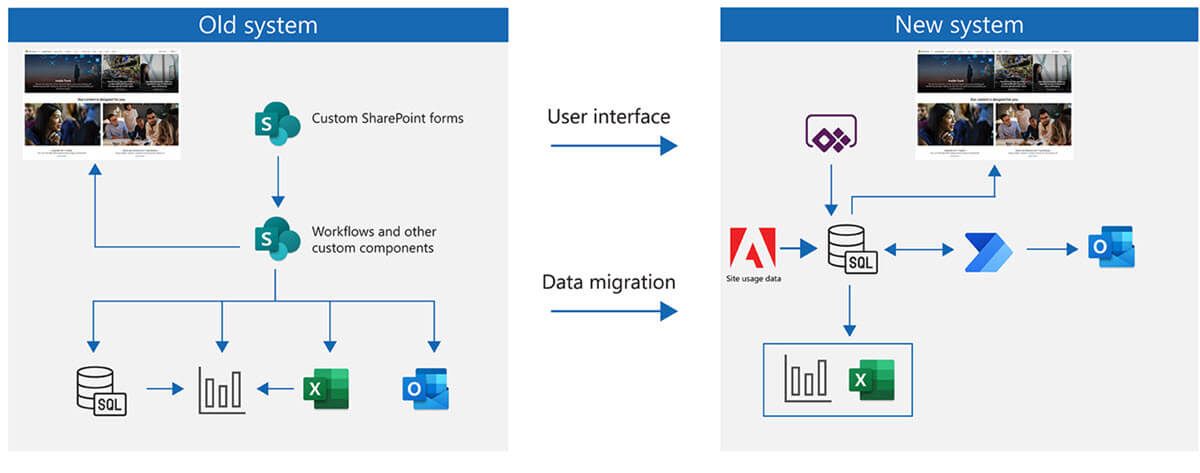
The migration from the old system to the new included:
- SharePoint data to Microsoft Azure SQL: We took the opportunity to move our data from SharePoint and Microsoft Excel to a SQL database. Most of the static data moved easily, but because the team wanted to keep the new environment in sync while tested, it used Microsoft Power Automate to sync changes with the legacy system and transform any data that needed extra attention on the new platform.
- Custom SharePoint UI to Microsoft Power Apps: To ease user transition, the team kept a similar interface with the new UI, but some controls (like multi-select combo boxes and the ability to search for multiple people across the org) didn’t work the same in Microsoft Power Apps. In these cases, the team built alternatives where needed using a customized view and low code solutions.
- Microsoft Power Automate for workflow: Because Microsoft Power Automate seamlessly integrates with the platforms the team was using, Peyton and the rest of the team had already been moving their workflows to Microsoft Power Automate. With the ability to invoke stored procedures in SQL, the team has even more options and flexibility to meet its automation needs.
- Microsoft Power BI for dashboards: This was the heaviest lift of the migration. With plenty of deprecated data in the old system, it was time to rebuild these from scratch. The team moved to shared data sources, making it easy to create multiple reports without rebuilding its datasets each time.
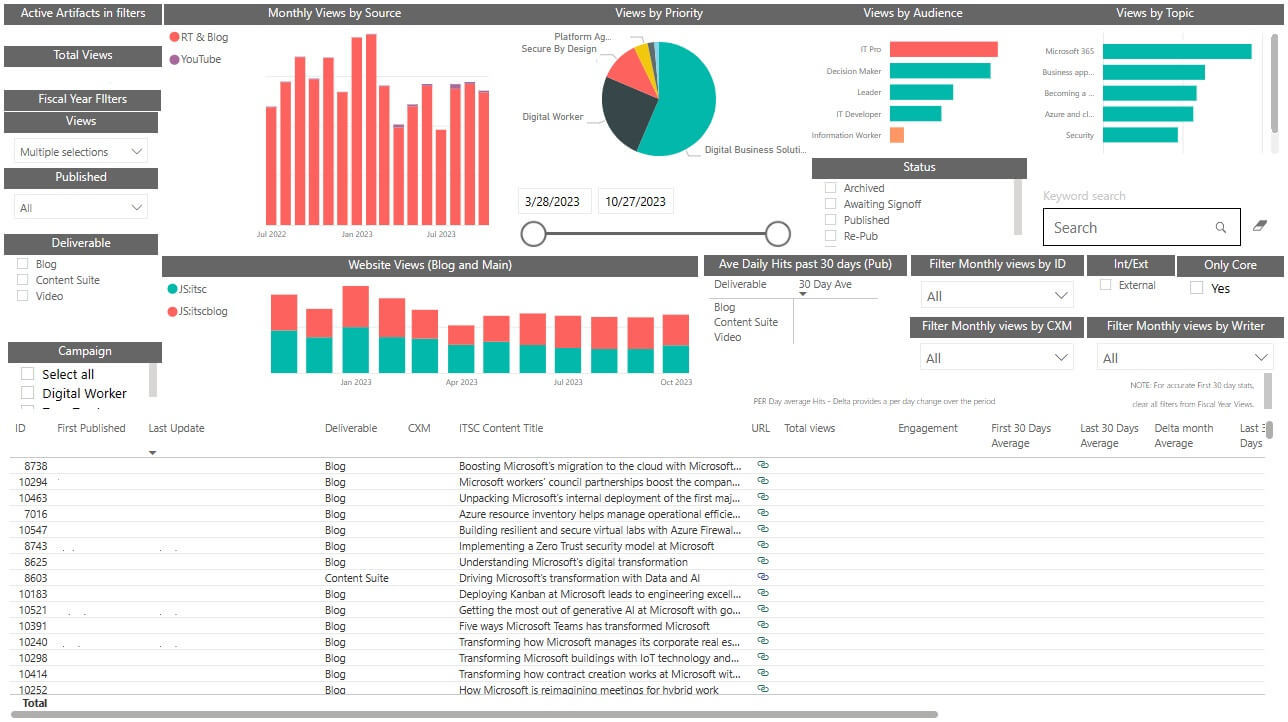
Flipping the switch
The development of the new system took six months.
Peyton and the team embarked on the migration first in an exploratory sense. There was much back and forth about how Microsoft Power Platform could meet the business needs without any functional loss—and with the exploration, a lot of prototyping was involved.
Months later, when it came time to complete the migration, the system only had to go offline for a few hours.
“When it was time to flip the switch, it was scary, and we were a little nervous at first,” Peyton says, explaining that they need not have worried—everything worked seamlessly. “I was really pleased with the increased performance—things were loading much quicker.”
Microsoft Power Platform enables professional developers like Peyton to accelerate their solutions. Using Adobe Analytics and Microsoft Azure SQL with Microsoft Power Platform meant that Peyton could hook up a SQL database with workflow, reporting, and a powerful front end without writing code. Professional developers have shifted to avoid building more code than necessary to reduce performance errors.
“Whereas before we had to do some wild data transformations on the previous system (the older SharePoint), we were able to step back and say that we can do this with SQL,” Peyton says. “Because of the interoperability of the Power Platform, we can move to managing data in native environments where you can get much more efficient processing.”
But, he says, there were pain points.
With Microsoft Power Platform, they did initially give up some functionality. One of those, Peyton says, was related to data sheet views.
“We lasted only a week before the people who used data sheet views said nope,” Peyton says.
The data sheet view offered the ability to make changes to multiple fields across several records directly to the underlying data without using the main form. It was only really for experienced power users. But, within hours, the team was able to build a separate Power App that provided the necessary access to the desired fields without compromising the data.
While building the UI, it was easy to keep accessibility standards in mind with the new platform capabilities.
“Having an agile or low-code environment can make it easy to push out new changes, which means your product can be in tune and responsive to updated compliance and policy updates,” Peyton says.
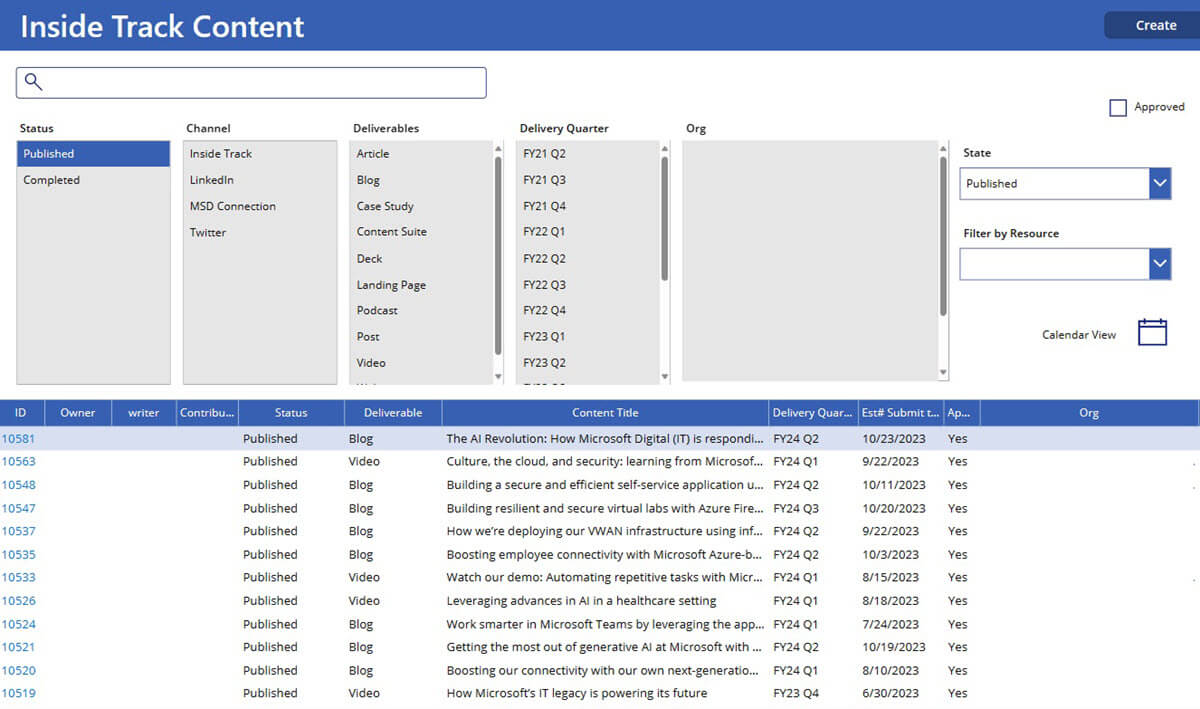
“There’s such a breadth of interoperability,” Peyton says. “The system allows you to focus on what you need and offload what you don’t.”
Problem-solving without the burden of technical problems
Velush says, Microsoft Power Platform “allows the people who know the business to solve business problems and not have to worry too much about technical problems.”
From being faster, easily customizable, scalable, fully compliant, and having capabilities that charm both citizen and pro developers, Microsoft Power Platform has become the answer to a legacy system that Inside Track had outgrown.
“We have the agility and flexibility to take this system wherever we want from here,” Velush says.
Creating customized views in the Power Platform, whether it’s in Power Apps, Power Automate, or Power BI, offers several significant benefits to the Inside Track team and leadership teams. These customized views enhance visibility, decision-making, and overall efficiency with the use of tailored insights, efficient data access, personalization to fit each user’s needs and role-based access to support the pillars of Microsoft’s Zero Trust security efforts.
In the early phases of development, the new system was only shared with the team via direct access, this meant members of the team had to request permission and wait for approval from the tool owner. After the system was established, it shifted to Entra ID (formerly Azure Active Directory) to allow collaboration across Microsoft Digital.

Integrating new programs
The team sought out solutions with Power Platform to address evolving business needs. By adjusting the views of the new Power App and related dashboards, the team is able to quickly respond with custom views and tools that can handle the scale of our content portfolio.
We needed to efficiently manage content promotions across various social media platforms and ensure older stories were assessed by the subject matter experts to ensure we’re providing modern solutions to customers and employees.
The custom views based off the new system created a unified place for end-to-end promotion management. This allowed collaborators in Microsoft Digital to jump into the application with little to no experience. Collaborators could quickly see all the information needed to promote stories and track when and where a story was featured.
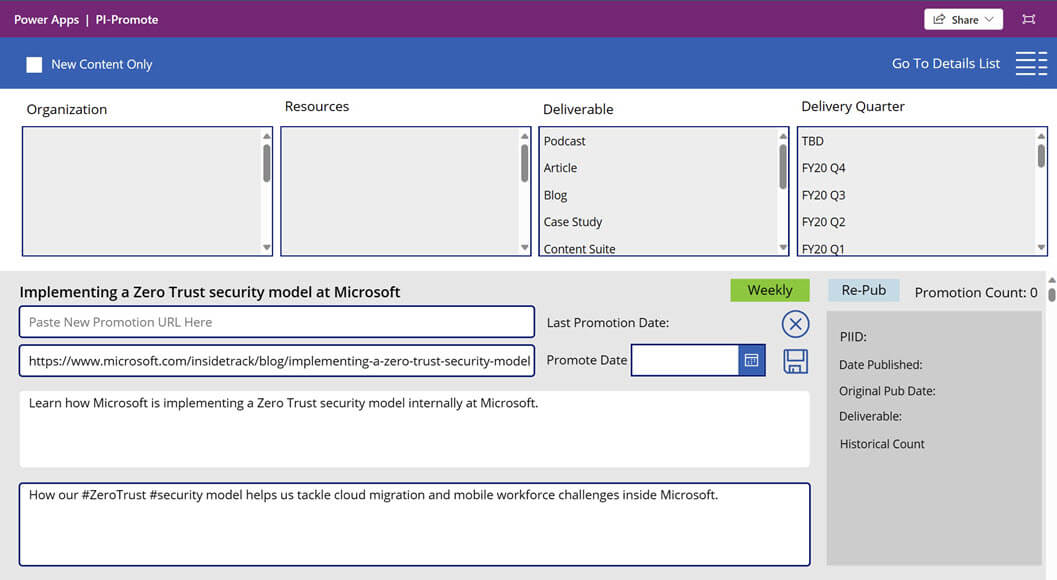
Auditing the content portfolio on Inside Track’s internal and external sites was a manual process for the team and took up valuable time. There are rapid changes around Microsoft and establishing a program that reviewed and worked to update stories was almost a full-time job by itself.
“We were able to rapidly build a solution that helped with a specific business problem,” says Jenny Neill, a project manager on the developer team for Inside Track. “We needed to get our arms around a large set of content that hasn’t been looked at in a long time. We needed a different lens, and it was possible to develop the requirements in a new Power App and bolt it onto the existing data structure.”
The Power Platform provided a needed solution at the right time.
“After hearing the challenges from one of the content experience managers, it was clear we needed to create a system to efficiently support the program,” Velush says. “Tracey and the developer team responded with a prototype that was already functional within the week.”
Peyton and the developer team created custom views in Power BI and a new Power App to support Inside Track in six weeks. “It was a radical improvement, our CXM was able to scale up the program and it was easy to check-in on the program with the familiar interface,” Velush says.
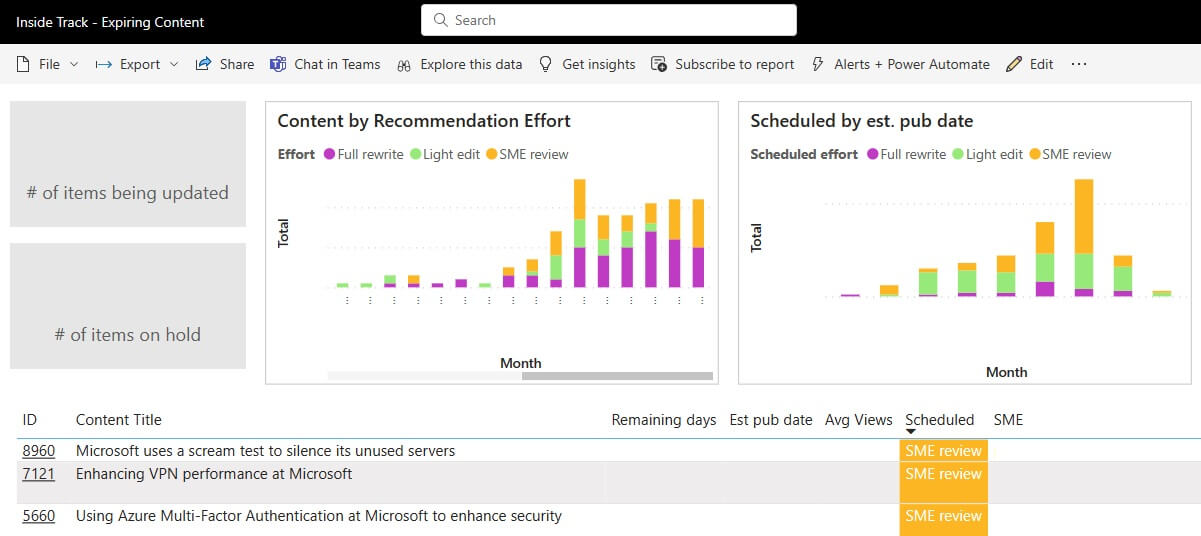
The success of Microsoft Power Platform, Peyton says, can ultimately be traced to the system being able to flawlessly integrate—and Microsoft’s willingness to cater to the “next level” of integration.
“Over the last few years, Microsoft has made a great effort to refocus, ensuring they provide tools to developers so that they can interoperate with any environment; it doesn’t matter what you want to integrate with, regardless of platform,” Peyton says. “They’re giving developers the tools that they need to do what they need to do.”

- Consider scalability and interoperability: When modernizing a legacy system, prioritize scalability and interoperability. Ensure that the chosen technology stack can handle increased usage over time and seamlessly integrate with other platforms and systems.
- Empower citizen and pro developers: Utilize no-code or low-code platforms like Microsoft Power Platform to empower both citizen and professional developers within your organization. These platforms allow individuals with varying levels of technical expertise to collaborate efficiently.
- Prioritize compliance and policy responsiveness: Recognize that policies can change quickly in a business environment. Choose a modernization approach that allows you to respond rapidly to policy needs while maintaining compliance with data security and regulatory requirements.
- Customize and adapt: Be prepared to customize solutions to match the specific needs of different departments or teams within your organization. Modernization efforts should offer flexibility and the ability to adapt to unique requirements.

Build professional solutions with Power Apps.

- Experience SQL innovation on Azure.
- Create a data-driven culture with BI for all.
- Discover how citizen developers use Microsoft Power Apps to build an intelligent launch assistant.

Want more information? Email us and include a link to this story and we’ll get back to you.
Tags: Azure SQL, Power Apps, Power Automate, Power Platform, SQL, Workflow








